In this article:
Foot pain is a very common issue, and studies have shown the increasing prevalence of foot ache all over the world.
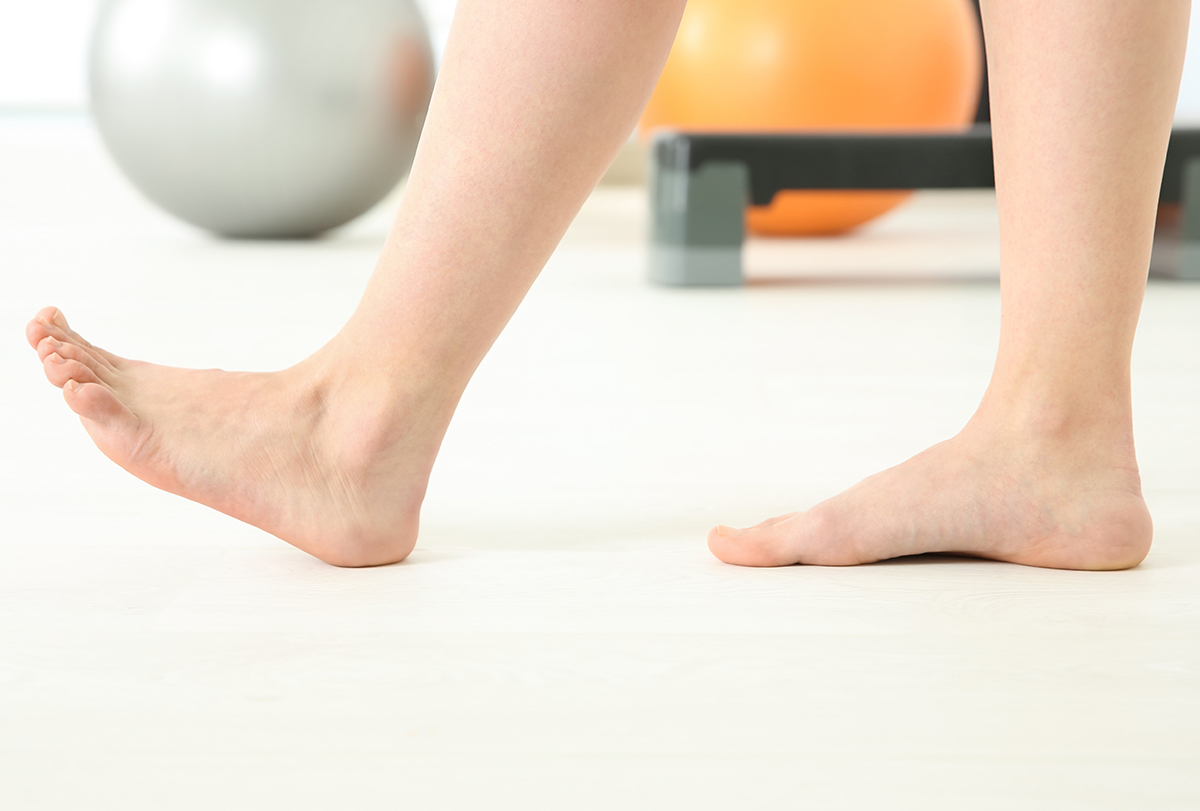
Women are more prone to suffering from foot pain than men. Other factors can also contribute to increased susceptibility to foot ache, and these include:
- Age
- Obesity
- Gender
- Pain in other body parts
The worrisome part is that foot ache can have negative impacts on your health. People fail to care for their feet until they start feeling the repercussions of poor foot health. They only start looking after their feet when they feel pain or other issues. (1)
Why Are Feet Prone to Pain?
It is no secret that your feet carry your entire body weight while you walk, run, and jog. Even when you stand, your feet take on all your body weight.
Pain or swelling can occur in various parts of the foot. These mostly include:
- Toes
- Heels
- Soles
- Arches
Foot ache can be a transient issue or severe. The intensity of pain can range from mild to extremely severe. The frequency of experiencing foot pain can also vary from person to person.
The bottom line is foot ache of any kind can hinder your day-to-day life. For serious foot pain, you need to seek medical help, but mild symptoms can be managed at home.
Reasons Your Feet Hurt So Much and How to Fix It
The main reasons your feet may hurt a lot include: (1)
1. High heels
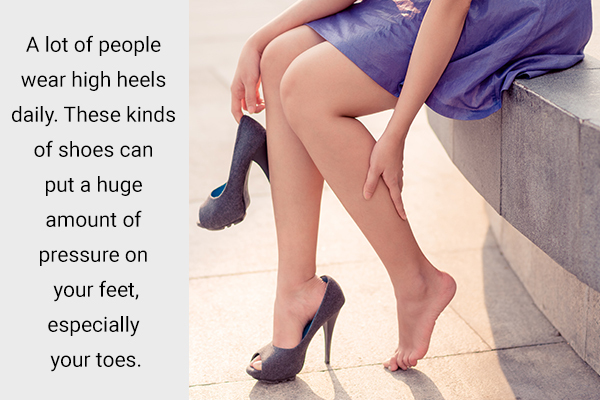
A lot of people wear high heels daily. These kinds of shoes can put a huge amount of pressure on your feet, especially your toes.
Heels that are over 2 inches or more can be very bad for your feet as they can affect your foot’s natural shape. Wearing high heels regularly can lead to pain and other issues including: (2)
- Increased risk of fractures
- Sprain in the ankles
How to deal with foot pain from wearing high heels:
- Look for heels that are thicker and bigger as they provide better balance and decrease pressure on your feet.
- Give your feet a break from high heels by wearing other more comfortable types of footwear. (3)
- It is always better to wear heels that are open toed as they will be more comfortable.
- You can add padding to your heels to avoid and protect blisters.
- After coming back home from a day of wearing high heels, soak your feet in warm water for a few minutes.
- Massage your feet every night for improved blood circulation and pain relief. (4)
2. Ill-fitting shoes
Wearing footwear that doesn’t fit you well can cause irritation and pain in your feet.
Ill-fitting shoes can be those that are either very tight or extremely narrow for your feet. These kinds of shoes put a lot of pressure on your toes and make your toes rub against your footwear, causing pain and inflammation. (5)
Walking around in shoes that don’t fit you too well can cause harm to the muscles, joints, and ligaments in your:
- Hips
- Back
- Feet
- Legs
Make sure that you’re aware of your shoe size and wear the right size every day. Moreover, get your shoe size checked every now and then as the feet tend to change with age. (6)
How to choose the right footwear:
- Wear good-quality shoes that support your soles and ankles well. (7)(6)
- Try to buy new shoes every few months for better comfort as old shoes can wear out.
- Before investing in any footwear, wear them and walk around the showroom to confirm that they fit you well.
- Wearing the right socks with the shoes is also important for foot comfort.
- You can also consult a doctor to know about any special footwear needs. (8)
3. Pregnancy
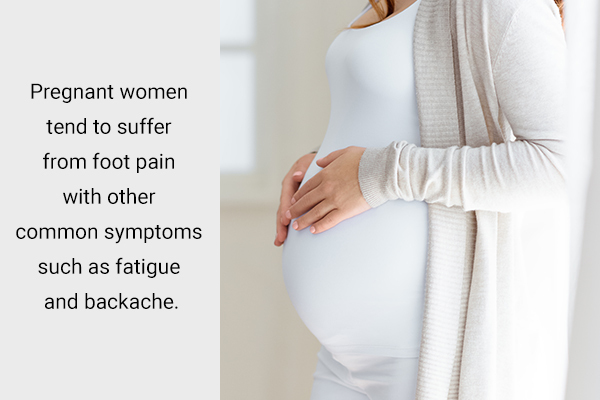
Pregnant women tend to suffer from foot pain with other common symptoms such as fatigue and backache.
When a woman is pregnant, her body weight increases, putting more pressure on her feet and legs, making them more tired. This increased weight will also change the woman’s center of gravity.
Foot pain is the worst during the last two trimesters of the pregnancy. The good news is that it almost completely vanishes after the delivery of the child. (9)
How to deal with foot pain during pregnancy:
- Elevate your feet while sleeping or sitting. (10)
- Drink plenty of fluids as dehydration increases inflammatory symptoms such as pain and swelling.
- Perform ankle rotation and other exercises for improved blood circulation. (11)
- Apply a cold compress to your feet every day for at least 15 minutes.
4. Standing for long durations
Many people stand and walk around every day without experiencing issues, but problems can arise when you need to stand for long hours as it can cause: (12)
- Sore feet
- Swelling
- Pain
- Inflammation
- Sprain
Additionally, standing for long periods puts excessive pressure on the joints, ligaments, and muscles of your feet and legs. (12)
How to reduce foot pain from standing for long hours:
- Wear comfortable footwear if you have to stand for long durations.
- Shift your weight from one leg to another every few minutes. (13)
- Try to take a sitting break every few minutes.
- Stretch your legs periodically while standing.
- Apply a cold compress at night before bed.
- Elevate your legs while sleeping.
5. Flat foot
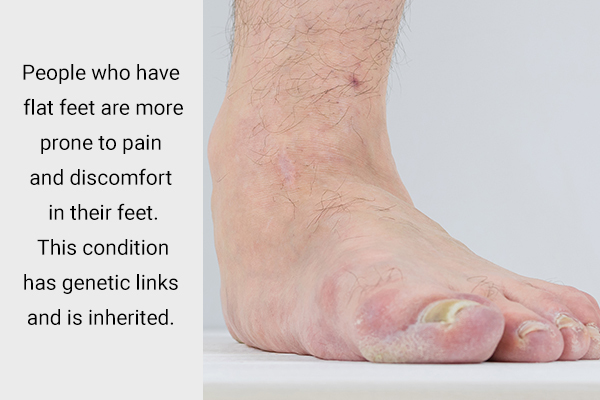
People who have flat feet are more prone to pain and discomfort in their feet. This condition has genetic links and is inherited. It is called a flat foot because the arch of the foot disappears, giving it a flat look.
People who wear high heels regularly and have to stand for hours daily can also develop flat feet later in life, irrespective of their genetic makeup.
Due to the loss of arch in the feet, ligaments in the ankle are not able to withstand increased pressure and strain, leading to ankle pain and weakness. (14)
How to deal with foot pain associated with flat feet:
- Try to walk barefoot on comfortable terrains for a good muscle workout.
- Stretch your heel cord to strengthen the tendons and muscles.
- Invest in the right kind of footwear that provides support to your feet.
6. Diabetes
Diabetes puts you at risk of various other health conditions, and diabetic neuropathy is one of them. This leads to damage in the nerves of your feet, causing numbness and pain in your feet.
Diabetes can lead to poor circulation of blood, especially in the feet and the legs, and therefore increased risk of foot pain. (15)
How to control foot pain when you have diabetes:
- Keep your blood sugar under control with proper disease management that includes regular monitoring of blood sugar levels.
- Soak your feet in warm water daily and clean them with antiseptic soaps.
- Consult a specialist for specialized footwear that provides support and aid to your feet.
7. Knee osteoarthritis
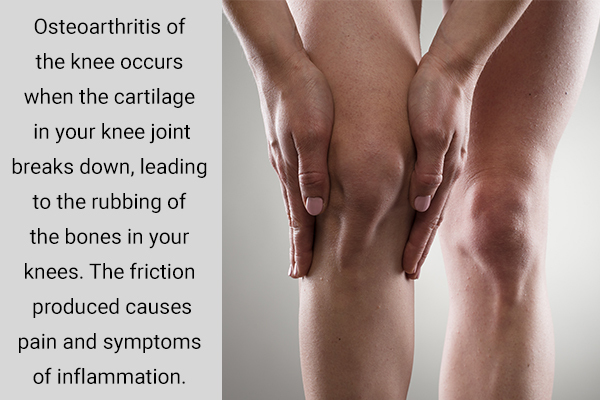
Osteoarthritis of the knee occurs when the cartilage in your knee joint breaks down, leading to the rubbing of the bones in your knees. The friction produced causes pain and symptoms of inflammation.
Osteoarthritis doesn’t have a cure yet, but medicines are available that prevent the worsening of the condition and slow down its progression. People who suffer from knee osteoarthritis commonly complain of foot pain. (16)
8. Calluses
Calluses are portions of the skin that harden over time because of excessive stress or pressure on them. They are usually seen on the sole of the feet.
Calluses can cause a lot of pain and discomfort if not treated on time. They’re usually caused by unhealthy walking posture, ill-fitting shoes, or stress on the foot. (17)
How to control foot pain from calluses:
- Wearing padded footwear is helpful to control calluses.
- Reduce pressure on the affected area.
- Apply topical medicine to the callus to slow down its growth.
- Trim off the calluses.
When to See a Doctor
Seek medical attention immediately if:
- Your foot pain continues to worsen or doesn’t get better over time.
- Swelling accompanies the foot pain.
- You have an open wound on your foot or pus is coming out of it, which can be signs of infection or inflammation.
- You are unable to walk due to excessive weight on the foot.
Most-Asked Questions About Foot Pain
What are ingrown toenails?
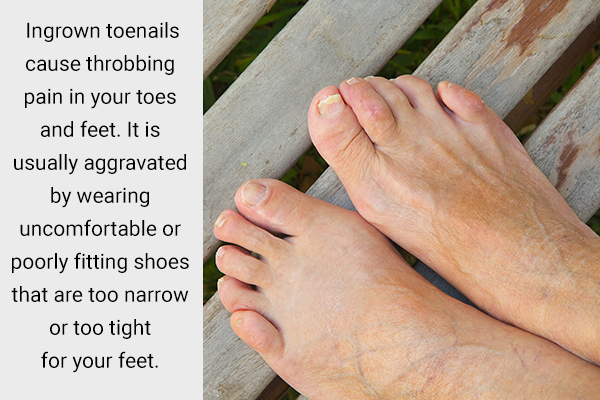
Sometimes, the hedge of your nail may curl downward and start digging into the skin of your toe. This condition is called ingrown toenails, which can be extremely painful.
Ingrown toenails cause throbbing pain in your toes and feet. It is usually aggravated by wearing uncomfortable or poorly fitting shoes that are too narrow or too tight for your feet. (18)
How to avoid foot pain from ingrown toenails?
To deal with foot pain arising from ingrown toenails, follow these steps:
- Soak your feet in warm water to lower inflammatory symptoms such as swelling and pain. You can add Epsom salt to the water for increased effectiveness of the remedy.
- Floss the nail edge gently to avoid its further growth into the skin.
- Trip the nail if you can to avoid infections or seek medical help. (18)
Can high uric acid levels cause foot pain?
Having high levels of uric acid in the body can be a cause of foot pain.
Uric acid is a waste product in the body that is produced after your body oxidizes the purines. Uric acid is excreted out via urine, but if accumulated in the body or blood, it can cause issues such as gout and arthritis. These problems further lead to foot pain and discomfort. (19)
How do I deal with gout-related foot pain?
- Drink enough water and fluids to promote the filtration of uric acid from the body.
- Reduce your intake of animal protein such as meat and poultry.
- Avoid eating food rich in purines such as mushrooms, legumes, and beans.
- Eat foods rich in fiber.
- Do not drink too much alcohol.
- Exercise regularly and make sure you have a healthy body weight.
What are bunions?
Bunions are another condition that leads to foot pain. They are deformities in your big toe that can lead to severe pain, especially when you’re waking. They can lower your toe flexibility and cause pain in the foot, hip, knee, and also lower back.
Bunions can be seen in both big toes or either one. They only get worse with time; hence, the pain may get more severe day by day.
Bunions are linked to an increased risk of corns and calluses as well. (20)
How to lower foot pain associated with bunions?
- Apply a cold compress to the affected area of the foot.
- Massage the foot with warm oil regularly.
- Wear comfortable shoes that do not put pressure on your big toe.
- Do not wear shoes that are too narrow.
- Avoid wearing high heels.
- Use bunion splints or other supportive devices such as padding in shoes. (20)
What serious underlying foot or medical conditions can cause your feet to hurt all the time?
Here are some health issues that can cause painful feet:
- Foot ulcers
- Arthritis
- Tendinitis
- Fracture
- Sprain
- Nerve damage
- Clogged arteries
- Athlete’s foot
- Gout
- Hammer toes
- Plantar fasciitis
- Warts
- Morton’s neuroma
Final Word
It is important to take care of your feet to reduce the incidences of foot pain. Our feet bear the weight of our entire body, so it is very important to support their health by wearing the right footwear, giving them proper rest, and getting treated for any issue that might worsen foot pain.
Make sure you don’t take foot pain too lightly. It can be a frustrating condition that should be catered to as a priority.
- Was this article helpful?
- YES, THANKS!NOT REALLY


